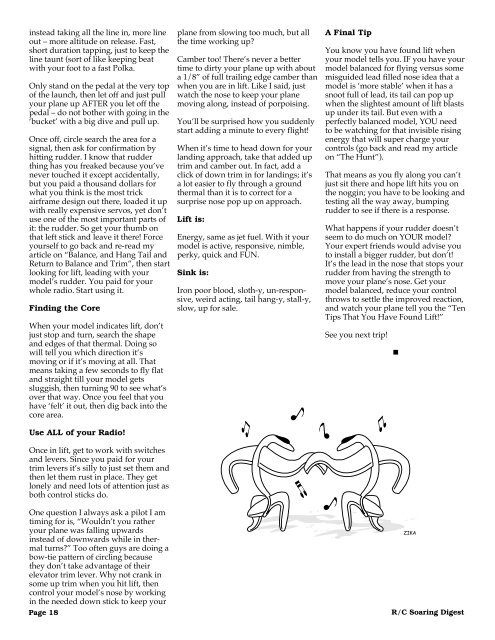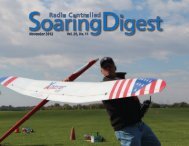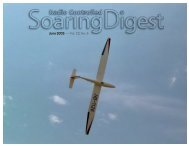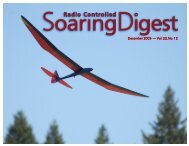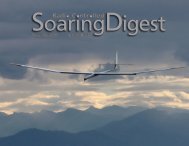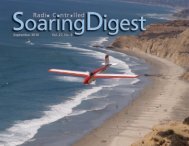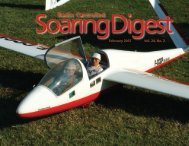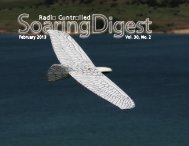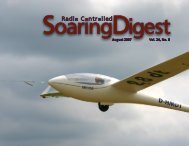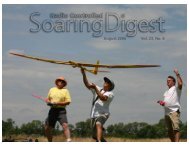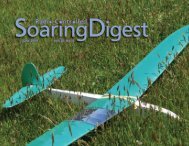4/03 RCSD - RC Soaring Digest - Rcsoaring.com
4/03 RCSD - RC Soaring Digest - Rcsoaring.com
4/03 RCSD - RC Soaring Digest - Rcsoaring.com
Create successful ePaper yourself
Turn your PDF publications into a flip-book with our unique Google optimized e-Paper software.
instead taking all the line in, more line<br />
out – more altitude on release. Fast,<br />
short duration tapping, just to keep the<br />
line taunt (sort of like keeping beat<br />
with your foot to a fast Polka.<br />
Only stand on the pedal at the very top<br />
of the launch, then let off and just pull<br />
your plane up AFTER you let off the<br />
pedal – do not bother with going in the<br />
‘bucket’ with a big dive and pull up.<br />
Once off, circle search the area for a<br />
signal, then ask for confirmation by<br />
hitting rudder. I know that rudder<br />
thing has you freaked because you’ve<br />
never touched it except accidentally,<br />
but you paid a thousand dollars for<br />
what you think is the most trick<br />
airframe design out there, loaded it up<br />
with really expensive servos, yet don’t<br />
use one of the most important parts of<br />
it: the rudder. So get your thumb on<br />
that left stick and leave it there! Force<br />
yourself to go back and re-read my<br />
article on “Balance, and Hang Tail and<br />
Return to Balance and Trim”, then start<br />
looking for lift, leading with your<br />
model’s rudder. You paid for your<br />
whole radio. Start using it.<br />
Finding the Core<br />
When your model indicates lift, don’t<br />
just stop and turn, search the shape<br />
and edges of that thermal. Doing so<br />
will tell you which direction it’s<br />
moving or if it’s moving at all. That<br />
means taking a few seconds to fly flat<br />
and straight till your model gets<br />
sluggish, then turning 90 to see what’s<br />
over that way. Once you feel that you<br />
have ‘felt’ it out, then dig back into the<br />
core area.<br />
Use ALL of your Radio!<br />
Once in lift, get to work with switches<br />
and levers. Since you paid for your<br />
trim levers it’s silly to just set them and<br />
then let them rust in place. They get<br />
lonely and need lots of attention just as<br />
both control sticks do.<br />
One question I always ask a pilot I am<br />
timing for is, “Wouldn’t you rather<br />
your plane was falling upwards<br />
instead of downwards while in thermal<br />
turns?” Too often guys are doing a<br />
bow-tie pattern of circling because<br />
they don’t take advantage of their<br />
elevator trim lever. Why not crank in<br />
some up trim when you hit lift, then<br />
control your model’s nose by working<br />
in the needed down stick to keep your<br />
Page 18<br />
plane from slowing too much, but all<br />
the time working up?<br />
Camber too! There’s never a better<br />
time to dirty your plane up with about<br />
a 1/8” of full trailing edge camber than<br />
when you are in lift. Like I said, just<br />
watch the nose to keep your plane<br />
moving along, instead of porpoising.<br />
You’ll be surprised how you suddenly<br />
start adding a minute to every flight!<br />
When it’s time to head down for your<br />
landing approach, take that added up<br />
trim and camber out. In fact, add a<br />
click of down trim in for landings; it’s<br />
a lot easier to fly through a ground<br />
thermal than it is to correct for a<br />
surprise nose pop up on approach.<br />
Lift is:<br />
Energy, same as jet fuel. With it your<br />
model is active, responsive, nimble,<br />
perky, quick and FUN.<br />
Sink is:<br />
Iron poor blood, sloth-y, un-responsive,<br />
weird acting, tail hang-y, stall-y,<br />
slow, up for sale.<br />
A Final Tip<br />
You know you have found lift when<br />
your model tells you. IF you have your<br />
model balanced for flying versus some<br />
misguided lead filled nose idea that a<br />
model is ‘more stable’ when it has a<br />
snoot full of lead, its tail can pop up<br />
when the slightest amount of lift blasts<br />
up under its tail. But even with a<br />
perfectly balanced model, YOU need<br />
to be watching for that invisible rising<br />
energy that will super charge your<br />
controls (go back and read my article<br />
on “The Hunt”).<br />
That means as you fly along you can’t<br />
just sit there and hope lift hits you on<br />
the noggin; you have to be looking and<br />
testing all the way away, bumping<br />
rudder to see if there is a response.<br />
What happens if your rudder doesn’t<br />
seem to do much on YOUR model?<br />
Your expert friends would advise you<br />
to install a bigger rudder, but don’t!<br />
It’s the lead in the nose that stops your<br />
rudder from having the strength to<br />
move your plane’s nose. Get your<br />
model balanced, reduce your control<br />
throws to settle the improved reaction,<br />
and watch your plane tell you the “Ten<br />
Tips That You Have Found Lift!”<br />
See you next trip!<br />
<br />
ZIKA<br />
R/C <strong>Soaring</strong> <strong>Digest</strong>


